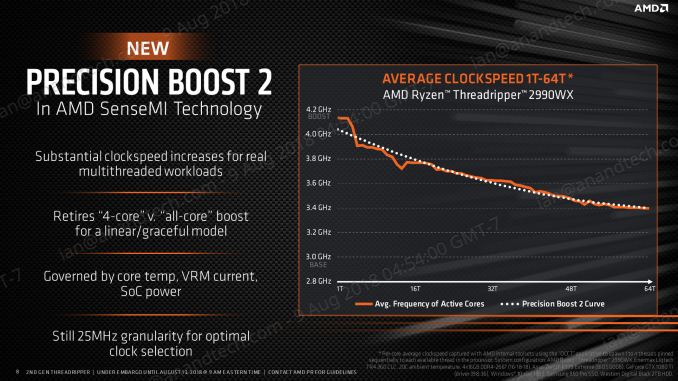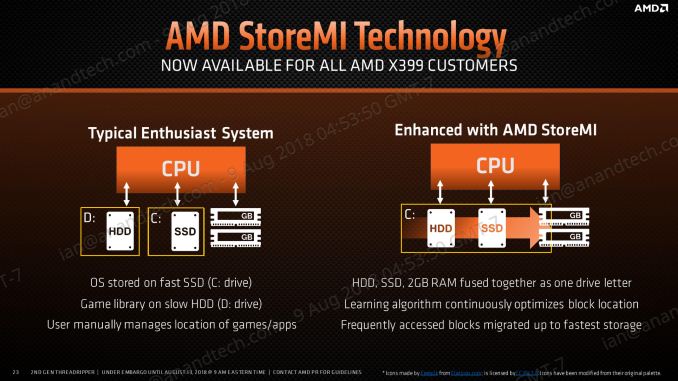The AMD Threadripper 2990WX 32-Core and 2950X 16-Core Review
by Dr. Ian Cutress on August 13, 2018 9:00 AM ESTPrecision Boost 2
Exact per-core turbo timings for the new processors will be determined by AMD’s voltage-frequency scaling functionality through Precision Boost 2. This feature, which we covered extensively in our Ryzen 7 2700X review, relies on available power and current to determine frequency, rather than a discrete look-up-table for voltage and frequency based on loading. Depending on the system default capabilities, the frequency and voltage will dynamically shift in order to use more of the power budget available at any point in the processor loading.
The idea is that the processor can use more of the power budget available to it than a fixed look up table that has to be consistent between all SKUs that are stamped with that number.
Precision Boost 2 also works in conjunction with XFR2 (eXtreme Frequency Range) which reacts to additional thermal headroom. If there is additional thermal budget, driven by a top-line cooler, then the processor is enabled to use more power up to the thermal limit and get additional frequency. AMD claims that a good cooler in a low ambient situation can compute >10% better in selected tests as a result of XFR2.
Ultimately this makes testing Threadripper 2 somewhat difficult. With a turbo table, performance is fixed between the different performance characteristics of each bit of silicon, making power the only differentiator. With PB2 and XF2, no two processors will perform the same. AMD has also hit a bit of a snag with these features, choosing to launch Threadripper 2 during the middle of a heatwave in Europe. Europe is famed for its lack of air conditioning everywhere, and when the ambient temperature is going above 30ºC, this will limit additional performance gains. It means that a review from a Nordic publication might see better results than one from the tropics, quite substantially.
Luckily for us we tested most of our benchmarks while in an air conditioned hotel thanks to Intel’s Data-Centric Innovation Summit which was the week before launch.
Precision Boost Overdrive
The new processors also support a feature called Precision Boost Overdrive, which looks at three key areas for power, thermal design current, and electrical design current. If any of these three areas has additional headroom, then the system will attempt to raise both the frequency and the voltage for increased performance. PBO is a mix of ‘standard’ overclocking, giving an all core boost, but gives a single core frequency uplift along with the support to still keep Precision Boost trying to raise frequency in middle-sized workloads, which is typically lost with a standard overclock. PBO also allows for idle power saving with a standard performance. PBO is enabled through Ryzen Master.
The three key areas are defined by AMD as follows:
- Package (CPU) Power, or PPT: Allowed socket power consumption permitted across the voltage rails supplying the socket
- Thermal Design Current, or TDC: The maximum current that can be delivered by the motherboard voltage regulator after warming to a steady-state temperature
- Electrical Design Current, or EDC: The maximum current that can be delivered by the motherboard voltage regulator in a peak/spike condition
By extending these limits, PBO gives rise for PB2 to have more headroom, letting PB2 push the system harder and further. PBO is quoted by AMD as supplying up to +16% performance beyond the standard.
AMD also clarifies that PBO is pushing the processor beyond the rated specifications and is an overclock: and thus any damage incurred will not be protected by warranty
StoreMI
Also available with the new Ryzen Threadripper 2 processors is StoreMI, AMD’s solution to caching by offering configurable tiered storage for users that want to mix DRAM, SSD, and HDD storage into a single unified platform. The software implementation dynamically adjusts data between up to 2GB of DRAM, up to 256 GB of SSD (NVMe or SATA), and a spinning hard drive to afford the best reading and writing experience when there isn’t enough fast storage.
AMD initially offered this software as a $20 add-on to the Ryzen APU platform, then it became free (up to a 256GB SSD) for the Ryzen 2000-series processors. That offer now extends to Threadripper. AMD’s best case scenario is citing a 90% improvement in loading times.













171 Comments
View All Comments
MrSpadge - Monday, August 13, 2018 - link
I don't think AVX512 is going to matter much anytime soon. However, The 8 memory channels of EPYC could matter a lot for HPC.ElFenix - Monday, August 13, 2018 - link
You guys need a 4k or maybe even 5k workload for transcoding - it's thread limited at 1080p so it becomes IPC and turbo limited. With x265 you can load up multiple 1080p handbrake instances on these high core count processors and they don't break a sweat.ElFenix - Monday, August 13, 2018 - link
That should be *1080p spawns limited numbers of threads*T1beriu - Monday, August 13, 2018 - link
>Europe is famed for its lack of air conditioning everywhereUK is a lot colder generally in the summer compared to the rest of Europe. I wouldn't generalize the lack of AC for the rest of Europe. AC is pretty common in my country.
jospoortvliet - Saturday, August 18, 2018 - link
Missing everywhere here in Germany... though after this insanely hot summer i bet that that will begin to change...powerincarnate - Monday, August 13, 2018 - link
I didn't see a lot of gaming benchmarks, which I guess I understand, since these are more workstation cpus. It would be good to have seen both though to get a better idea of the overall qualities of the cpu as a multipurpose care.It seems from tomshardware benches that 7980xe, especially when overclocked, is best overall. AMD 2990wx obviously winning on the pure multi-threaded workstation stuff as long as it is not memory intensive.
It seems like the 2950x from both of these sites, is really the processor to get from the threadripper lineup.
it seems when gaming is taken to account, the best of both worlds is the 7900x
And for gaming, and when you factor price as well, the 8700k, 8086, and slightly behind, the 2700x are the cards to get.
Overall.... I'm a little disappointed in this release. Was much more impressed with the 2700x. It's likely since we didn't really get a true change in the manufacturing process or design of the chip, that the limitations of the 2990wx will probably be ironed out with Zen2 (this is Zen+ after all).
bill.rookard - Monday, August 13, 2018 - link
Looking at it myself, yeah - these really aren't gaming CPUs by any stretch of the imagination, thus the lack of gaming benchmarks is perfectly understandable to me. As for the results of the benchmark results? I'm thinking the 2950x is the sweet spot. Lower power, lower latency, more power for the cores vs interconnects, and a much higher clockspeed makes it IMHO the better choice unless you have those fringe workloads which requires a bunch-o-cores.shendxx - Monday, August 13, 2018 - link
this guy come from Toms that said 7900x is best for both world, lol, when the graph from toms show clearly even on gaming, 2950x is equal on Minimum FPS with 8700k and only lose 3 to 10 FPS On Average,apoclypse - Monday, August 13, 2018 - link
I don't know. Gaming performance is the least thing I care about with this chip but that seems be all most tech press cares about, especially tech tubers. These chips are not for gaming. If anything these chips should be compared to Intel's Xeon line as it seems that is actually where AMD is aiming these at since they don't have a dedicated SKU for workstation chips like Intel. These are only marketed as HEDT chips because it gives AMD positive press, but if anything the ones who should be paying attention should be OEM high end workstation builders. In that regard Threadripper is more than compelling. It's higher clocked than Intel's Xeon chips, has more cores for less money, and still has all the pro level features that is needed for workstation level work.I think AMD should lean into that a bit more in their marketing but that stuff isn't sexy and it doesn't grab attention like marketing it towards rich and stupid "gamers", and the technorati who eat that stuff up.
This is a workstation chip period, and should be treated, tested and benchmarked as such, imo.
Icehawk - Monday, August 13, 2018 - link
If only the tier 1 vendors would offer TR workstations... I really wanted to purchase a few for work to use as VM hosts but my only real option is Xeon currently. The 32 core monster would likely make for a great VM host for mid-weight usage.